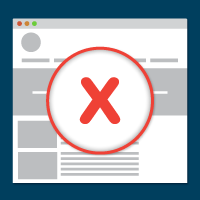Your User-Centered Design Isn’t Usable If It Isn’t Accessible
 What if you learned there’s an entire segment of users who find your user-centered design to be completely unusable? Not frustrating or difficult, but completely unusable?
What if you learned there’s an entire segment of users who find your user-centered design to be completely unusable? Not frustrating or difficult, but completely unusable?
These users can’t navigate around your website, they can’t use the input controls and they can’t understand the layout of the page itself. Your website won’t let them, because your design hasn’t addressed how they use the web.
These users are the millions of people with disabilities—users with vision, hearing or mobility challenges who access the internet with assistive technology (AT) like screen readers or sip and puff devices.
Experiencing the Web with a Disability
For most people, the internet has become a basic necessity for daily living and work. And for users with disabilities, the internet is just as essential—perhaps more so, because it’s often used to avoid the challenges and risks of activities like travel and shopping at the store. So the user experience is at least as important to people with disabilities as it is for others.
But often user-centered design and usability testing only consider the “typical” user, leaving needs of people with disabilities out of the equation. The result is a design that only gets it half right.
The issue is accessibility. While usability addresses questions of quality experience and user enjoyment, accessibility is about making sure everyone can understand, navigate and interact with websites and tools. In the end, no matter how usable your web design is, if it’s not accessible for users then it’s also not usable.
Does Accessibility Compete with Usability?
Many UX designers believe that accessibility and user experience design are fundamentally at odds with each other—that increasing accessibility decreases usability for typical users. While it’s true that many accessible websites are designed poorly, that doesn’t mean they have to be. This myth is based on the technology limitations that existed years ago. Nowadays, the tools and techniques used to make websites accessible are available in all web editors. Whether the site is well designed is a reflection of the time and effort put forth by the designer.
Still skeptical? Look at the site you’re reading right now! Our site applies good design heuristics and is fully accessible to people living with disabilities who use assistive technology.
Designing for Accessibility
You can design websites that are usable and also accessible to everyone. Deque has the tools and services to help you learn everything you need to know about web accessibility. Whether you just want to learn more about accessibility or need to move your company to comply with website accessibility standards, we can help!
Next Steps
- Learn more about how to get started with digital accessibility.
- Read about incorporating users with disabilities in UX testing.
- Watch users share their stories about web accessibility.
- Learn about our accessibility services.